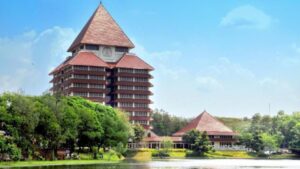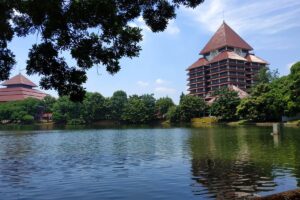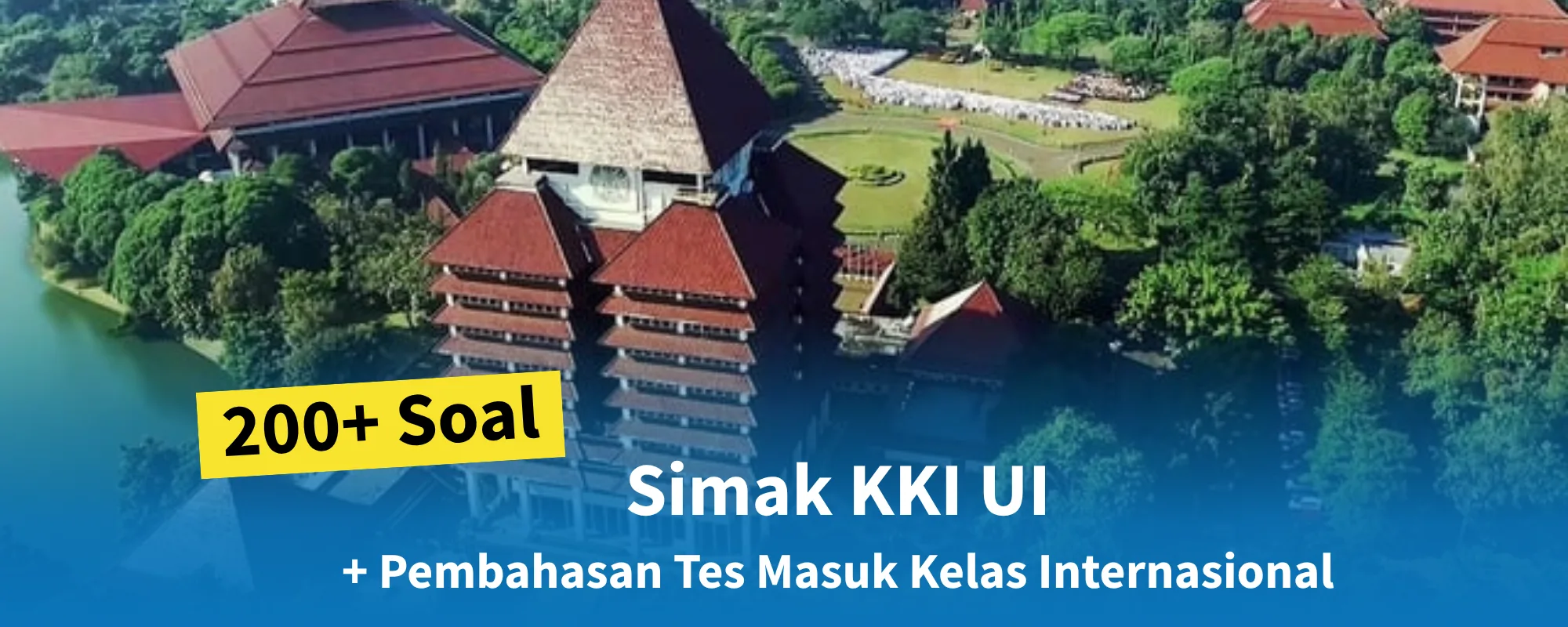Seleksi Masuk Universitas Indonesia Program Kelas Khusus Internasional (SIMAK UI KKI) merupakan jalur penerimaan yang dirancang khusus bagi calon mahasiswa yang ingin mengejar pendidikan bertaraf global di salah satu universitas terbaik di Indonesia. Program ini menawarkan sistem pembelajaran berstandar internasional, pengantar bahasa Inggris, serta peluang mengikuti program gelar ganda (double degree) dengan universitas mitra di luar negeri. Tak heran jika minat terhadap program ini terus meningkat dari tahun ke tahun, seiring dengan tingginya persaingan dan prestise yang dimiliki oleh lulusan KKI UI.
Untuk dapat lolos dalam SIMAK UI KKI, dibutuhkan persiapan yang matang, termasuk pemahaman soal-soal seleksi yang mencakup kemampuan akademik dan bahasa Inggris. Dalam artikel ini, kami menyajikan lebih dari 200 soal latihan lengkap dengan pembahasan yang dirancang untuk membantu calon peserta memahami pola soal, meningkatkan strategi pengerjaan, dan memperkuat kepercayaan diri dalam menghadapi ujian.
Table of Contents
ToggleKisi-kisi Soal Tes SIMAK KKI UI Masuk Kelas Internasional

Berikut kisi-kisi soal SIMAK KKI UI berdasarkan bidang studi yang diujikan, seperti kemampuan dasar, kemampuan IPA/IPS, serta tes kemampuan berbahasa Inggris. Dengan memahami struktur dan fokus soal yang sering muncul, kamu bisa lebih siap dalam menyusun strategi belajar dan meningkatkan peluang untuk lolos ke program studi impian di UI Kelas Internasional.
Basic Mathematics
- Operasi Aljabar
Peserta diharapkan mampu memahami dan mengerjakan berbagai bentuk operasi bilangan dalam bentuk aljabar, seperti penjumlahan, pengurangan, perkalian, dan pembagian ekspresi aljabar. Selain itu, mencakup kemampuan menyelesaikan persamaan dan pertidaksamaan linear satu variabel maupun dua variabel, serta persamaan kuadrat. Penguasaan terhadap faktorisasi dan manipulasi bentuk aljabar seperti menyederhanakan bentuk pecahan aljabar dan menyusun ekspresi matematika juga diuji.
- Sistem Persamaan
Materi ini mencakup penyelesaian sistem persamaan linear dua atau tiga variabel dengan metode substitusi, eliminasi, dan determinan (metode matriks). Peserta harus mampu memilih metode yang paling tepat dan efisien untuk menyelesaikan permasalahan sistem persamaan, baik yang kontekstual maupun bentuk formal aljabar.
- Geometri Dasar
Ujian mengukur kemampuan dalam memahami bangun datar (seperti segitiga, persegi, dan lingkaran) serta bangun ruang (seperti kubus, balok, tabung, dan kerucut). Peserta diminta menghitung keliling, luas permukaan, dan volume, serta memahami sifat-sifat geometri seperti simetri, sudut, dan relasi antar elemen geometri.
- Teorema Pythagoras
Soal dalam bagian ini menuntut penerapan Teorema Pythagoras untuk menyelesaikan persoalan dalam bidang dua dimensi. Termasuk penghitungan panjang sisi segitiga siku-siku, jarak titik dalam bidang, hingga aplikasi praktis seperti soal cerita yang melibatkan koordinat atau pengukuran tak langsung.
- Statistik Deskriptif
Menguji kemampuan peserta dalam mengolah dan menganalisis data sederhana. Termasuk menghitung ukuran pemusatan data seperti mean (rata-rata), median, dan modus, serta menyajikan data dalam bentuk tabel frekuensi, diagram batang, diagram lingkaran, dan histogram.
- Peluang Dasar
Peserta diharapkan memahami dasar-dasar teori peluang, termasuk cara menghitung kemungkinan suatu kejadian terjadi (kejadian tunggal dan majemuk), serta penerapan prinsip permutasi dan kombinasi dalam konteks sederhana seperti pengaturan tempat duduk atau pemilihan tim.
English
- Reading Comprehension
Kemampuan ini mengukur sejauh mana peserta dapat memahami teks bacaan berbahasa Inggris, khususnya teks akademik. Fokus pada kemampuan mengidentifikasi gagasan utama, informasi pendukung, membuat inferensi logis, dan memahami struktur paragraf termasuk penanda wacana.
- Grammar and Structure
Menguji pemahaman peserta terhadap tata bahasa Inggris, termasuk penggunaan tenses (present, past, future), bentuk pasif (passive voice), struktur kalimat kompleks, penggunaan conjunctions, dan preposisi. Fokus pada penerapan grammar dalam kalimat-kalimat akademik dan kontekstual.
- Vocabulary Contextual
Peserta harus mampu memahami makna kata atau frasa dalam konteks kalimat. Termasuk penggunaan sinonim, antonim, idiom, dan phrasal verbs yang umum dijumpai dalam teks bacaan akademik atau percakapan formal.
- Error Identification
Bagian ini menguji kejelian peserta dalam mendeteksi kesalahan grammar atau struktur kalimat. Diberikan kalimat lengkap, peserta diminta memilih bagian mana yang salah secara tata bahasa atau susunan kata.
Quantitative/Numeric Reasoning
- Aritmetika Dasar
Kemampuan dalam menyelesaikan operasi hitung dasar dengan cepat dan akurat, termasuk operasi pecahan, desimal, persen, rasio, dan proporsi. Soal-soal dalam bagian ini biasanya berbentuk soal cerita sederhana yang melibatkan penghitungan sehari-hari.
- Pemecahan Masalah Numerik
Peserta diuji kemampuannya dalam menyelesaikan soal logika matematika berbasis cerita (word problem) yang membutuhkan beberapa tahapan pengerjaan. Penekanan pada kemampuan memahami soal, menyusun model matematis, dan menyelesaikan perhitungan dengan tepat.
- Estimasi dan Konversi
Melibatkan kemampuan memperkirakan hasil hitung secara cepat (misalnya pembulatan) serta konversi antar satuan panjang, massa, waktu, dan mata uang. Fokus pada efisiensi pengerjaan dan pemahaman satuan baku.
- Interpretasi Data
Peserta diminta membaca dan memahami informasi dari berbagai bentuk penyajian data seperti tabel, grafik batang, diagram garis, dan pie chart. Kemampuan menyimpulkan tren atau pola dari data yang disajikan sangat penting dalam bagian ini.
Logical Reasoning
- Penalaran Deduktif
Mengukur kemampuan berpikir logis melalui argumen deduktif. Peserta diberikan satu atau lebih premis dan diminta menarik kesimpulan logis. Contoh: “Jika semua A adalah B, dan C adalah A, maka C adalah B.”
- Penalaran Induktif
Fokus pada kemampuan mengamati pola atau urutan (baik angka, huruf, maupun gambar), dan memprediksi elemen selanjutnya berdasarkan pola yang ada. Soal semacam ini menuntut kejelian dan intuisi terhadap bentuk atau angka.
- Analisis Pernyataan
Peserta diminta menganalisis hubungan logis antar pernyataan. Bisa dalam bentuk silogisme, pengelompokan himpunan (menggunakan diagram Venn), atau validitas argumen. Tujuannya menguji pemahaman terhadap struktur logika formal.
- Logika Visual
Menguji kemampuan berpikir spasial dan pengenalan pola visual. Peserta melihat deret atau urutan gambar, lalu diminta menentukan gambar selanjutnya atau yang tidak sesuai dengan pola.
Contoh Soal Tes SIMAK KKI UI Masuk Kelas Internasional

Salah satu kunci sukses dalam menghadapi Tes SIMAK UI KKI adalah dengan memahami jenis dan karakteristik soal yang akan diujikan. Dengan berlatih contoh-contoh soal, calon mahasiswa dapat mengasah kemampuan berpikir kritis, logika, serta pemahaman bahasa Inggris yang menjadi aspek penting dalam seleksi masuk kelas internasional.
1 (Algebraic Expressions – HOTS)
A company produces x units of a product daily. The cost to produce x units is given by the expression:
C(x) = 5x + 300/x
If the company wants to minimize the cost per unit, which of the following statements is true?
A. Cost per unit decreases as x increases indefinitely
B. Cost per unit is minimized when x = 10
C. Cost per unit is minimized when x = 15
D. Cost per unit is minimized when x = 20
E. Cost per unit is constant for any x > 0
Answer: D
Explanation:
Cost per unit = C(x)/x = (5x + 300/x)/x = 5 + 300/x²
To minimize the cost per unit, we minimize 300/x², which decreases as x increases. Trying different values:
- x = 10 → 5 + 300/100 = 8
- x = 15 → 5 + 300/225 ≈ 6.33
- x = 20 → 5 + 300/400 = 5.75 → lowest so far
Hence, cost per unit is minimized at x = 20 (among the options).
2 (System of Equations – HOTS Contextual)
You have two containers. The first contains water and sugar in the ratio 2:3, and the second in the ratio 4:1. If you mix 5 liters from each container, what is the ratio of water to sugar in the final mixture?3:2
A. 7:3
B. 7:7
C. 5:5
D. 6:4
E. 8:7
Answer: A
Explanation:
Container 1 (5 liters, ratio 2:3):
Water = 2/5 * 5 = 2 L, Sugar = 3/5 * 5 = 3 L
Container 2 (5 liters, ratio 4:1):
Water = 4/5 * 5 = 4 L, Sugar = 1/5 * 5 = 1 L
Total: Water = 2 + 4 = 6 L, Sugar = 3 + 1 = 4 L
So the ratio is 6:4 = 3:2
But 3:2 is not among the options, so check again.
Correction:
First container:
Water = (2/5)*5 = 2, Sugar = (3/5)*5 = 3
Second container:
Water = (4/5)*5 = 4, Sugar = (1/5)*5 = 1
Total Water = 6, Sugar = 4 → 6:4 = 3:2
3 (Geometry – 3D Shapes & Surface Area)
A closed cylindrical can has a radius of 7 cm and height of 10 cm. If the top and bottom are painted red and the side is painted blue, what is the total painted area?
A. 440 cm²
B. 704 cm²
C. 748 cm²
D. 814 cm²
E. 1000 cm²
Answer: C
Explanation:
Area of top and bottom = 2 * π * r² = 2 * 22/7 * 7² = 2 * 154 = 308 cm²
Side area = 2 * π * r * h = 2 * 22/7 * 7 * 10 = 440 cm²
Total painted area = 308 + 440 = 748 cm²
4 (Pythagorean Theorem – Contextual Distance Problem)
A man walks 6 km north and then 8 km east. How far is he from the starting point?
A. 10 km
B. 12 km
C. 14 km
D. 16 km
E. 18 km
Answer: A
Explanation:
The man forms a right triangle with legs 6 km and 8 km.
Use the Pythagorean Theorem:
Distance = √(6² + 8²) = √(36 + 64) = √100 = 10 km
5 (Descriptive Statistics – Mean, Median, Mode)
The ages of 7 students are: 18, 20, 22, 22, 24, 25, 25.
What is the median age?
A. 20
B. 22
C. 23
D. 24
E. 25
Answer: B
Explanation:
Since the data is already sorted and has 7 values, the median is the 4th number → 22
Soal Nomor 1 (Reading Comprehension – HOTS)
Read the following passage:
“In recent years, scientists have turned their attention to bioplastics—plastics made from renewable biological sources, such as corn starch or sugarcane. These materials are often marketed as a sustainable alternative to petroleum-based plastics. However, while bioplastics can reduce dependence on fossil fuels, they still raise concerns regarding agricultural land use and long-term environmental impact.”
Which of the following best summarizes the main idea of the paragraph?
A. Bioplastics are cheaper than traditional plastics.
B. Bioplastics are made from sugar and corn only.
C. Bioplastics are a perfect solution to plastic pollution.
D. Bioplastics may be a greener option, but they also come with drawbacks.
E. Scientists oppose the use of bioplastics in packaging.
Answer: D
Explanation:
The passage introduces bioplastics as a renewable alternative but immediately highlights concerns. Option D best summarizes this balance of potential and concern.
6 (Grammar and Structure – Tenses & Passive Voice)
Choose the correct form to complete the sentence:
By the time the lecture started, the report ___ by most students.
A. has submitted
B. was submitted
C. had been submitted
D. have been submitted
E. is submitted
Answer: C
Explanation:
The sentence uses a past perfect structure. The correct passive past perfect is “had been submitted”.
7 (Vocabulary Contextual – Idioms & Phrasal Verbs)
Read the sentence:
The manager said the new policy would weed out employees who were not meeting the standards.
What is the meaning of “weed out” in this context?
A. Promote
B. Replace
C. Train
D. Eliminate
E. Encourage
Answer: D
Explanation:
“Weed out” means to remove or eliminate unwanted elements—in this case, underperforming employees.
8 (Error Identification – Grammar)
Choose the part of the sentence that contains an error:
The professor, along with his assistants, have prepared a new syllabus for the next semester.
A. The professor
B. along with
C. his assistants
D. have prepared
E. a new syllabus
Answer: D
Explanation:
The subject “The professor” is singular. “Along with his assistants” is a phrase and does not affect the verb. The correct verb form is “has prepared,” not “have prepared”.
9 (Reading Comprehension – Inference)
Read the sentence:
Despite her extensive knowledge in the field, she remains humble and always open to feedback.
What can be inferred about the person described?
A. She dislikes receiving criticism.
B. She is confident but not arrogant.
C. She refuses to accept new ideas.
D. She avoids teamwork.
E. She has limited experience.
Answer: B
Explanation:
The sentence shows she is knowledgeable but remains humble and open, suggesting confidence without arrogance.
10 (Basic Arithmetic – Fractions & Percentage)
A student scores 72 out of 90 in Mathematics and 48 out of 60 in English. In which subject did the student perform better in terms of percentage?
A. Mathematics, 78%
B. English, 80%
C. Mathematics, 80%
D. English, 82%
E. Both subjects have the same percentage
Answer: C
Explanation:
- Mathematics: (72/90) × 100 = 80%
- English: (48/60) × 100 = 80%
Both are 80%, but option C is the correct format.
11 (Numeric Problem Solving – Multi-Step)
A shop offers a 20% discount on a jacket priced at $150. After the discount, a tax of 10% is added to the discounted price. What is the final price?
A. $120
B. $135
C. $132
D. $138
E. $126
Answer: C
Explanation:
- Discounted price: 150 × (1 – 0.20) = $120
- After tax: 120 × 1.10 = $132
12 (Estimation & Conversion – Units)
A car travels 150 kilometers in 2 hours and 30 minutes. Approximately, what is its average speed in meters per second (m/s)?
A. 16 m/s
B. 18 m/s
C. 20 m/s
D. 22 m/s
E. 24 m/s
Answer: B
Explanation:
- 2 hours 30 minutes = 2.5 hours = 9000 seconds
- 150 km = 150,000 meters
- Speed ≈ 150,000 / 9000 = 16.67 ≈ 17 m/s, closest option is 18 m/s
13 (Data Interpretation – Table)
Refer to the table below:
| Year | Sales ($ in thousand) |
| 2020 | 120 |
| 2021 | 135 |
| 2022 | 150 |
| 2023 | 165 |
In which year did the sales increase by the highest percentage compared to the previous year?
A. 2021
B. 2022
C. 2023
D. Both 2021 and 2023
E. All years had equal increase
Answer: A
Explanation:
- 2021: (135 – 120) / 120 = 12.5%
- 2022: (150 – 135) / 135 = 11.1%
- 2023: (165 – 150) / 150 = 10%
→ Highest percentage increase was in 2021.
14 (Numeric Problem Solving – Logical Story)
If a train leaves City A at 08:00 AM traveling at 60 km/h, and another train leaves City B (120 km away) at 09:00 AM heading toward City A at 90 km/h, at what time will they meet?
A. 10:00 AM
B. 10:15 AM
C. 10:30 AM
D. 10:45 AM
E. 11:00 AM
Answer: B
Explanation:
- First train travels 1 hour = 60 km before second starts
- Distance left = 60 km
- Closing speed = 60 + 90 = 150 km/h
- Time to meet = 60 / 150 = 0.4 hr = 24 minutes
→ 09:00 + 24 minutes = 09:24 AM + 1 hour = 10:15 AM
15 (Deductive Reasoning)
Statement:
All scientists are curious.
Some curious people are not researchers.
Dr. Hana is a scientist.
Which of the following must be true?
A. Dr. Hana is not a researcher.
B. Dr. Hana is not curious.
C. Dr. Hana is a researcher.
D. Dr. Hana is curious.
E. Dr. Hana is both curious and a researcher.
Answer: D
Explanation:
From the first statement: all scientists are curious → Dr. Hana is a scientist, so she must be curious.
We do not have information about whether she is a researcher or not, so only option D must be true.
16 (Inductive Reasoning – Number Pattern)
What is the next number in the following sequence?
2, 4, 8, 16, 32, ___
A. 40
B. 48
C. 56
D. 60
E. 64
Answer: E
Explanation:
This is a geometric sequence with ×2 pattern:
2 → 4 → 8 → 16 → 32 → 64
17 (Statement Analysis – Syllogism)
Statement 1: Some cats are pets.
Statement 2: All pets are animals.
Conclusion:
I. Some cats are animals.
II. All animals are cats.
Which conclusion logically follows?
A. Only I
B. Only II
C. Both I and II
D. Neither I nor II
E. Cannot be determined
Answer: A
Explanation:
From the two statements:
Some cats are pets → all pets are animals → some cats must be animals (I is true).
II is not logically supported.
18 (Visual Logic – Pattern Completion)
🟦⬜🟩⬜🟦⬜🟩⬜…
Which shape comes next?
A. 🟦
B. ⬜
C. 🟩
D. 🟥
E. 🟨
Answer: A
Explanation:
The pattern repeats every 3 shapes: 🟦⬜🟩
So the 10th shape is the same as the 1st → 🟦
19 (Inductive Reasoning – Letter Pattern)
Find the next group in the pattern:
AB, CD, EF, GH, __
A. HI
B. IJ
C. JK
D. KL
E. MN
Answer: C
Explanation:
The pattern moves 2 letters forward each time:
A-B → C-D → E-F → G-H → J-K
20 (Reading Comprehension)
Read the passage below and answer the question:
“While many believe that technological advancement always leads to a better quality of life, critics argue that the overuse of digital tools has created new forms of dependency and stress, particularly among younger generations.”
What is the main idea of the passage?
A. Technology makes life easier for everyone.
B. Critics think digital tools have no value.
C. Technology has created new problems despite its benefits.
D. Young people use technology more efficiently than adults.
E. The older generation benefits most from technology.
Answer: C
Explanation:
The passage presents both views, but the main idea centers around the negative impact of technology despite its benefits, especially on younger people.
Persiapkan Dirimu dengan Materi dan Soal UTBK Lengkap di UTBK.id!
![]() Siap untuk meraih hasil terbaik di UTBK? Dapatkan akses ke koleksi soal latihan, penjelasan rinci, dan materi pembelajaran lengkap di utbk.or.id. Baik untuk persiapan SIMAK KKI UI maupun ujian masuk lainnya, semua yang kamu butuhkan untuk sukses ada di sini. Kunjungi sekarang dan mulai perjalananmu menuju kesuksesan!
Siap untuk meraih hasil terbaik di UTBK? Dapatkan akses ke koleksi soal latihan, penjelasan rinci, dan materi pembelajaran lengkap di utbk.or.id. Baik untuk persiapan SIMAK KKI UI maupun ujian masuk lainnya, semua yang kamu butuhkan untuk sukses ada di sini. Kunjungi sekarang dan mulai perjalananmu menuju kesuksesan!




